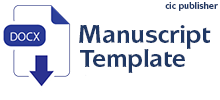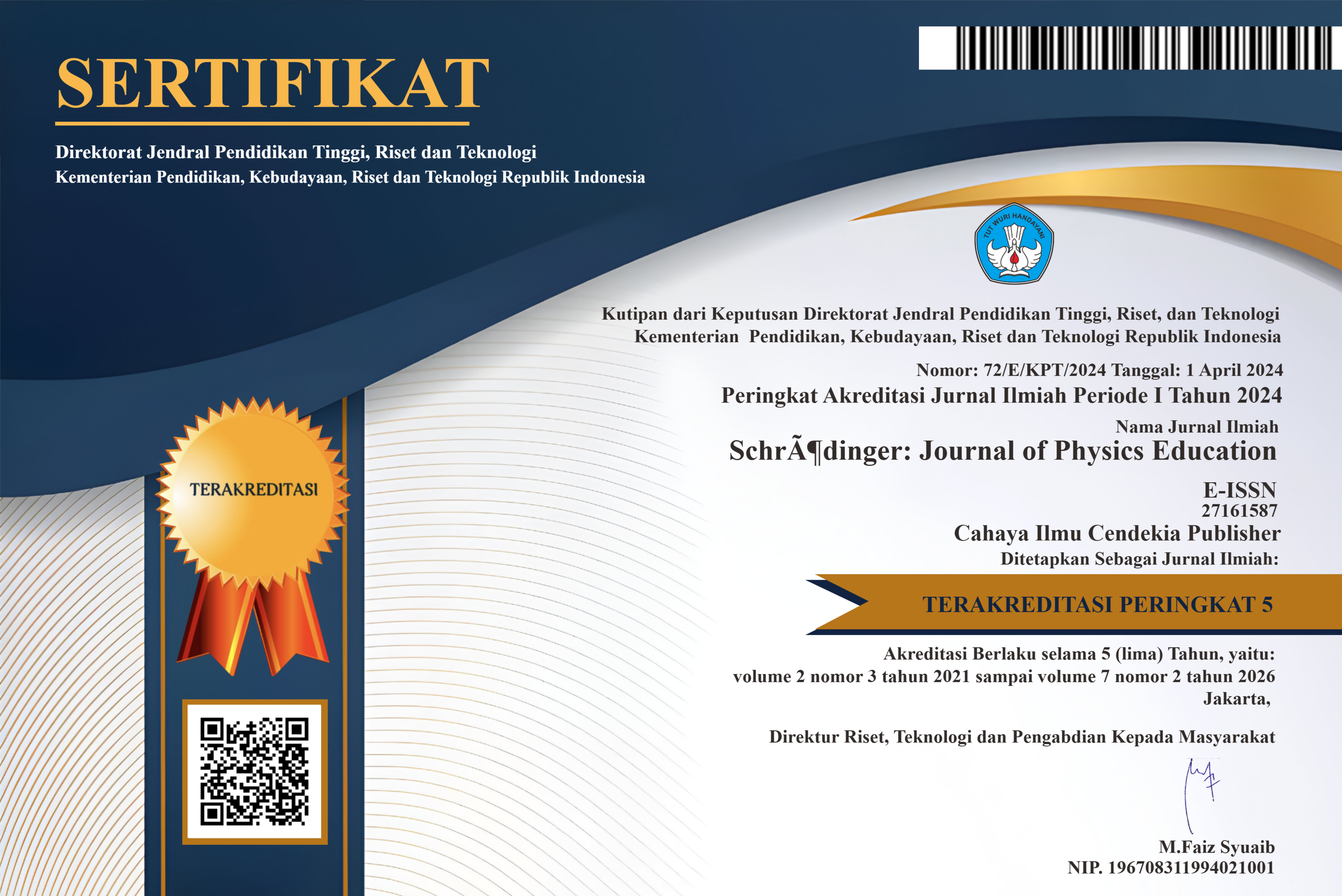Attitude of Students' Interest in Learning Physics
Abstract
Purpose of the study: This study aims to determine students' attitudes towards physics subjects through indicators of adoption of a scientific attitude, interest in increasing the time to study physics and career interest in physics in high schools..
Methodology: This type of research is survey research with the instrument used is a questionnaire. Data analysis in this study used quantitative research using the SPSS program to carry out descriptive statistical tests. The research subjects were 60 students. Quantitative data analysis techniques using descriptive statistics.
Main Findings: The results of the analysis obtained from the indicators of adopting a scientific attitude are in the good category. Indicators of interest in increasing the time to study physics and career interest in physics are in the moderate category. Based on these results, students at SMA Negeri 2 Jambi City have an adequate attitude towards learning physics. The results showed that in the first indicator, students' social implications for Physics were included in the good category. In the second indicator, attitudes towards physics investigations are included in the fairly good category. And on the third indicator, the desire to have a career in Physics is included in the good category.
Novelty/Originality of this study: Describe how the attitude of students' interest in learning physics in high school.
References
L. Stinken-Rösner, L. Rott, S. Hundertmark, T. Baumann, J. Menthe, T. Hoffmann, and S. Abels, “Thinking inclusive science education from two perspectives: Inclusive pedagogy and science education,” Research in Subject-matter Teaching and Learning (RISTAL), vol. 3, no. 1, pp. 30-45, 2020, doi: 10.23770/rt1831.
S. Nida, S. Rahayu, and I. Eilks, "A survey of Indonesian science teachers’ experience and perceptions toward socio-scientific issues-based science education," Education Sciences, vol. 10, no. 2, pp. 39, 2020, doi: 10.3390/educsci10020039.
L. Ding, “Theoretical perspectives of quantitative physics education research,” Phys. Rev. Phys. Educ. Res., vol. 15, no. 2, p. 20101, 2019, doi: 10.1103/PhysRevPhysEducRes.15.020101
C. Rapanta, L. Botturi, P. Goodyear, L. Guàrdia, and M. Koole, "Balancing technology, pedagogy and the new normal: Post-pandemic challenges for higher education," Postdigital Science and Education, vol. 3, no. 3, pp. 715-742, 2021, doi: 10.1007/s42438-021-00249-1.
A. Shahzad, R. Hassan, A. Y. Aremu, A. Hussain, and R. N. Lodhi, "Effects of COVID-19 in E-learning on higher education institution students: the group comparison between male and female," Quality & quantity, vol. 55, pp. 805-826, 2021, doi: 10.1007/s11135-020-01028-z.
J. Varghese and S. S. Crawford, “A cultural framework for Indigenous, Local, and Science knowledge systems in ecology and natural resource management,” Ecol. Monogr., vol. 91, no. 1, p. e01431, 2020, doi: 10.1002/ecm.1431.
D. Henriksen, S. Gretter, and C. Richardson, "Design thinking and the practicing teacher: Addressing problems of practice in teacher education," Teaching Education, vol. 31, no. 2, pp. 209-229, 2020, doi: 10.1080/10476210.2018.1531841.
R. Hoyi and L. Liza, “Identify the Disciplinary Attitude of Learning Physics in High School Students”, Jor. Eva. Edu, vol. 2, no. 1, pp. 39-43, 2021. doi: 10.37251/jee.v2i1.247.
Y. Futaba, “Inclusive Education Under Collectivistic Culture,” J. Res. Spec. Educ. Needs, vol. 16, no. S1, pp. 649–652, 2016, doi: 10.1111/1471-3802.12325.
A. Gupta, and P. Pathania, "To study the impact of Google Classroom as a platform of learning and collaboration at the teacher education level," Education and Information Technologies, vol. 26, no. 1, pp. 843-857, 2021, doi: 10.1007/s10639-020-10294-1.
A. Madsen, S. B. McKagan, and E. C. Sayre, “How physics instruction impacts students’ beliefs about learning physics: A meta-analysis of 24 studies,” Phys. Rev. Spec. Top. - Phys. Educ. Res., vol. 11, no. 1, pp. 1–19, 2015, doi: 10.1103/PhysRevSTPER.11.010115.
V. Jafari-Sadeghi, S. Kimiagari, and P. P. Biancone, "Level of education and knowledge, foresight competency and international entrepreneurship: A study of human capital determinants in the European countries," European Business Review, vol. 32, no. 1, pp. 46-68, 2020, doi: 10.1108/EBR-05-2018-0098.
R. S. Barthelemy, B. Van Dusen, and C. Henderson, “Physics education research: A research subfield of physics with gender parity,” Phys. Rev. Spec. Top. - Phys. Educ. Res., vol. 11, no. 2, pp. 1–10, 2015, doi: 10.1103/PhysRevSTPER.11.020107.
Muhammad Iqbal and R. O. Sandra, “Analysis Of Independent Attitude Of Students Of SMAN 2 Jambi City”, Jor. Eva. Edu, vol. 3, no. 3, pp. 77-81, Jul. 2022. doi: 10.37251/jee.v3i3.238.
R. Madhakomala, M. A. Hakim, and N. Syifauzzuhrah, "Problems of education in Indonesia and alternative solutions," International Journal of Business, Law, and Education, vol. 3, no. 2, pp. 135-144, 2022, doi: 10.56442/ijble.v3i3.64.
A. Ramadhanti, N. Natalia, E. Febri, and R. Fitriani, “Description of Motivation for Learning Physics for Class X Mathematics and Natural Sciences at SMAN 1 Jambi City”, Jor. Eva. Edu, vol. 3, no. 3, pp. 82-86, 2022. doi: 10.37251/jee.v3i3.245.
A. S. Munna, and M. A. Kalam, "Teaching and learning process to enhance teaching effectiveness: a literature review," International Journal of Humanities and Innovation (IJHI), vol. 4, no 1, pp. 1-4, 2021, doi: 10.33750/ijhi.v4i1.102.
A. L. Traxler, X. C. Cid, J. Blue, and R. Barthelemy, “Enriching gender in physics education research: A binary past and a complex future,” Phys. Rev. Phys. Educ. Res., vol. 12, no. 2, pp. 1–15, 2016, doi: 10.1103/PhysRevPhysEducRes.12.020114.
K. A. Anderson, M. Crespi, and E. C. Sayre, “Linking behavior in the physics education research coauthorship network,” Phys. Rev. Phys. Educ. Res., vol. 13, no. 1, pp. 1–10, 2017, doi: 10.1103/PhysRevPhysEducRes.13.010121.
A. Mutlu, “Evaluation of students’ scientific process skills through reflective worksheets in the inquiry-based learning environments,” Reflective Pract., vol. 21, no. 2, pp. 271–286, 2020, doi: 10.1080/14623943.2020.1736999.
F. K. Şemin, “Competencies of principals in ensuring sustainable education: Teachers’ views,” Int. J. Eval. Res. Educ., vol. 8, no. 2, pp. 201–212, 2019, doi: 10.11591/ijere.v8i2.18273.
Y. K. Raharjo, . S., and . W., “Need Analysis of Learning Model of History Integrated with Leadership Values of Mangkunegara I through Reflective Pedagogy Paradigm,” Int. J. Educ. Res. Rev., vol. 4, no. 4, pp. 617–623, 2019, doi: 10.24331/ijere.628436.
A. V. Knaub, J. M. Aiken, and L. Ding, “Two-phase study examining perspectives and use of quantitative methods in physics education research,” Phys. Rev. Phys. Educ. Res., vol. 15, no. 2, p. 20102, 2019, doi: 10.1103/PhysRevPhysEducRes.15.020102.
M. Planinic, W. J. Boone, A. Susac, and L. Ivanjek, “Rasch analysis in physics education research: Why measurement matters,” Phys. Rev. Phys. Educ. Res., vol. 15, no. 2, p. 20111, 2019, doi: 10.1103/PhysRevPhysEducRes.15.020111.
Y. Kee-Jiar and L. Shih-Hui, “A systematic review of parental attitude and preferences towards implementation of sexuality education,” Int. J. Eval. Res. Educ., vol. 9, no. 4, pp. 971–978, 2020, doi: 10.11591/ijere.v9i4.20877.
F. T. Aldila and E. F. S. Rini, “Teacher’s Strategy in Developing Practical Values of the 5th Pancasila Precepts in Thematic Learning in Elementary School”, J. Bs. Edu. R, vol. 4, no. 1, pp. 31-38, Jan. 2023. doi: 10.37251/jber.v4i1.301
A. Mbonyiryivuze, L. L. Yadav, and M. M. Amadalo, “Students’ attitudes towards physics in nine years basic education in rwanda,” Int. J. Eval. Res. Educ., vol. 10, no. 2, pp. 648–659, 2021, doi: 10.11591/ijere.v10i2.21173.
M. Khan, M. Abid Siddiqui, and K. L. Malone, "Scientific attitudes: gender differences, impact on physics scores and choices to study physics at higher levels among pre-college STEM students," International Journal of Science Education, vol. 44, no. 11, pp. 1816-1839, 2022, doi: 10.1080/09500693.2022.2097331.
B. Habig and P. Gupta, “Authentic STEM research, practices of science, and interest development in an informal science education program,” Int. J. STEM Educ., vol. 8, no. 1, 2021, doi: 10.1186/s40594-021-00314-y.
E. Ural, “The Effect of Guided-Inquiry Laboratory Experiments on Science Education Students’ Chemistry Laboratory Attitudes, Anxiety and Achievement,” J. Educ. Train. Stud., vol. 4, no. 4, pp. 217–227, 2016, doi: 10.11114/jets.v4i4.1395.
F. M. Mardiana and N. Y. Ningsih, “Cooperative Learning Model on Atomic Structure Material and It’s Influence on the Scientific Attitude of Class X Students at Senior High School”, In. Sci. Ed. J, vol. 4, no. 1, pp. 23-29, 2023. doi : 10.37251/isej.v4i1.273
E. Hacieminoglu, “Elementary School Students’ Attitude toward Science and Related Variables,” Int. J. Environ. Sci. Educ., vol. 11, no. 2, pp. 35–52, 2016.
R. Mohd, “A systematic review on the formative assessment practice in teaching and learning in secondary school,” Int. J. Eval. Res. Educ., vol. 13, no. 2, pp. 1173–1183, 2023, doi: 10.11591/ijere.v13i2.26187.
J. König, D. J. Jäger-Biela, and N. Glutsch, “Adapting to online teaching during COVID-19 school closure: teacher education and teacher competence effects among early career teachers in Germany,” Eur. J. Teach. Educ., vol. 43, no. 4, pp. 608–622, 2020, doi: 10.1080/02619768.2020.1809650.
J. Martín-Gutiérrez, C. E. Mora, B. Añorbe-Díaz, and A. González-Marrero, “Virtual technologies trends in education,” Eurasia J. Math. Sci. Technol. Educ., vol. 13, no. 2, pp. 469–486, 2017, doi: 10.12973/eurasia.2017.00626a.
S. Zubaidah, N. M. Fuad, S. Mahanal, and E. Suarsini, “Improving creative thinking skills of students through Differentiated Science Inquiry integrated with mind map,” J. Turkish Sci. Educ., vol. 14, no. 4, pp. 77–91, 2017, doi: 10.12973/tused.10214a.
R. E. Utami, A. Johari, and E. Anggereini, “Learning Outcomes for Students Junior High School: Entrepreneurship-Based Learning Video”, In. Sci. Ed. J, vol. 4, no. 2, pp. 69-76, May 2023. doi: 10.37251/isej.v4i2.328.
F. M. Mardiana and N. Y. Ningsih, “Cooperative Learning Model on Atomic Structure Material and It’s Influence on the Scientific Attitude of Class X Students at Senior High School”, In. Sci. Ed. J, vol. 4, no. 1, pp. 23-29, 2023. doi: 10.37251/isej.v4i1.273.
R. Martínez-Santos, M. P. Founaud, A. Aracama, and A. Oiarbide, “Sports Teaching, Traditional Games, and Understanding in Physical Education: A Tale of Two Stories,” Front. Psychol., vol. 11, no. September, 2020, doi: 10.3389/fpsyg.2020.581721.
Copyright (c) 2023 Deborah Masniari. S, Botir T Turaqulov, Josephat Kigo

This work is licensed under a Creative Commons Attribution-NonCommercial 4.0 International License.
Authors who publish with this journal agree to the following terms:
- Authors retain copyright and acknowledge that the Schrödinger: Journal of Physics Education is the first publisher licensed under a Creative Commons Attribution 4.0 International License.
- Authors are able to enter into separate, additional contractual arrangements for the non-exclusive distribution of the journal's published version of the work (e.g., post it to an institutional repository or publish it in a book), with an acknowledgment of its initial publication in this journal.
- Authors are permitted and encouraged to post their work online (e.g., in institutional repositories or on their website) prior to and during the submission process, as it can lead to productive exchanges and earlier and greater citation of published work.






.png)
.png)








.png)
.png)
.png)







